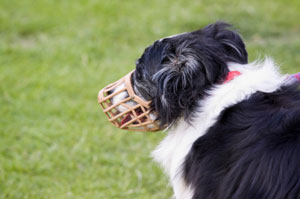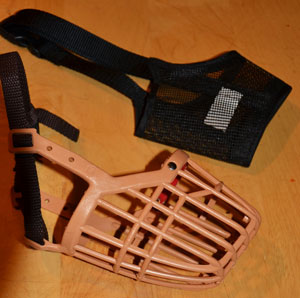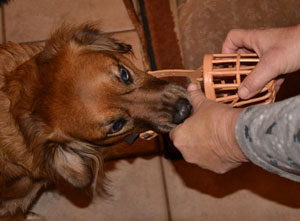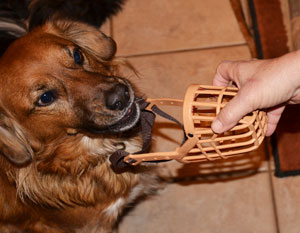Times are changing
For many people, the idea of a muzzle evokes a long-standing association with aggressive dogs. That impression can create feelings of fear and worry when people hear about or witness a dog in a muzzle. There is no denying that when many people see a muzzled dog, they envision the likes of a Hannibal Lecter character (a monster, but in fur)!
But, muzzles are not just for aggression anymore. It's high time to dispel those negative mental images. Rather than vilifying muzzles, it's time to appreciate muzzles for all the good things they can do for dogs.

The vet view
One place to begin is with some insight from the veterinary community. Jeannie Brousseau, RVT (Registered Vet Tech), with the Pasadena Humane Society and SPCA, once said, "Muzzles keep a good dog good."
Think about a typical vet visit with your own dog. Is she nervous, worried, anxious, or fearful? Many times dogs displaying those emotions are taken "to the back," where they receive routine, care such as vaccines. This is usually done to save you anxiety, in case your dog panics when handled for these procedures, and also to avoid bites. If a dog taken away from the owner shows any signs of biting, the dog is often muzzled—usually on the spot, and sometimes with a quick, but invasive, gauze wrapped around the snout.
If your dog has never worn a muzzle or been made to feel comfortable with one, there is a good chance that having one placed on her face abruptly could cause future handling issues, and more terror, the next time she has to visit the vet. This experience and reaction could easily generalize to not only the vet staff, but to other situations that might feel threatening to your dog when people approach your dog's head or face.
Start early and reap benefits for routine and emergency care
Being proactive and teaching your dog to love her muzzle before your next vet visit will minimize the handling, and/or the restraint by the vet staff. When you teach your dog to love wearing a muzzle, you can bring your dog's muzzle with you to the vet. Play fun muzzle games with the muzzle, and the end result will be that your dog will not have to be manhandled to get a muzzle on her when she needs to be examined or taken to "the back" for treatments.
If your dog is ever injured or hurt, having her comfortable with a muzzle can prevent a bite to the veterinary staff members trying to help your dog. If your dog bites someone at the vet, even if your dog is in pain, that bite is usually reported to the local Animal Control agency. As a result, in most states your dog will have to be placed in quarantine for approximately 10 days, adding insult to injury.
Keep in mind that if your dog is injured or in pain, placing a muzzle on her before you try to move her or transport her may also prevent a bite to you or to anyone else trying to help your dog get safely to a vet.
Video courtesy of Dearing English.
Touch can mean treats and trust
Teaching puppies to accept a muzzle is a wonderful way to work on general touching and handling. This training also teaches puppies to keep their mouths, and those sharp little teeth, away from you. Working on muzzle training produces the wonderful association between human hands and treats: "When hands come near my face, good things happen." With this motivation, puppies are quick to focus and learn to get their faces in the muzzle, and not to use your hands for teething.
The more puppies associate wearing a muzzle with a fun game, the quicker handling and touching exercises go overall, making it easy to make contact and reinforce touching other parts of the dogs' faces and bodies. If you have any remedial work to do with your dog in the area of handling, husbandry, or grooming, teaching your dog to wear a muzzle is a terrific way to desensitize common handling around the face and ears, before moving on to additional behavior modification for those sensitivities.
It is important to realize that desensitizing to handling and similar experiences takes more time than just teaching your dog to be comfortable wearing a muzzle. The time will be worth it in the long run, as your dog will feel safer. So will you, and others who might need to handle your dog. Take the time to associate the muzzle, and all the handling components necessary to fasten it, with pleasurable experiences. When you reward and reinforce with amazing food, you make the process even more agreeable for your dog.
The positive associations that go along with muzzle training will lead your dog to trust you. When you are more relaxed, your dog will be as well, making any process much easier.
Muzzles for new situations, new friends, and new challenges
The use of a muzzle has been an important tool in behavior modification if a dog is reactive. The muzzle allows you to be safe as you work around other dogs, or around people. Work with an experienced trainer, of course. If something goes wrong or if a boundary is crossed unknowingly, the muzzle will prevent your dog from biting, giving you peace of mind in a training class or similar situation.
Muzzles are also a valuable safety tool to employ when introducing another species to your dog during a desensitization program.
Traveling abroad with your dog is still another reason for teaching your dog to love a muzzle. More and more countries now require dogs of certain types and/or weights to wear muzzles. A ruined vacation might be in your future if you travel with your dog and have not taught her to enjoy wearing a muzzle. France, for instance, requires muzzles for larger dogs.
There are places right here in the United States where muzzles are now required. More and more cities are requiring breeds like pit bulls to wear a muzzle in public. Malden, Massachusetts, and Jefferson City, Missouri, have joined the ranks of cities that require pit bulls to wear muzzles, for example. These rules may not seem fair, but they are better than an outright ban on a breed like in Denver, Colorado, where pit bull and pit-bull-types are outlawed in the city.
Sports and games
Gaining in popularity is the dog sport of dog racing. Traditionally, this has been a sport for sight hounds, but now it's open to all breeds that love to run. Muzzles are required!
Muzzles can be used as a fun food toy. Use a basket muzzle as a puzzle by letting your dog figure out how to get treats from inside the muzzle, or ask your dog to use her tongue to lick up treats from the hole in the front of a soft, mesh muzzle!
Fitting a muzzle
Before discussing or describing the different types of muzzles, it's important to understand what a well-fitted muzzle looks like. The final fit for your dog should come after you have done basic training. It's not important in the early stages of training that the muzzle fit perfectly, only that your dog learns to love to put her face into it willingly.
When you are ready to size the muzzle, the first rule for a good fit is that the muzzle be snug, but not tight. The muzzle should also allow your dog to open her mouth, but it should prevent her from opening it all the way.
Having several adjustments from which to choose is important. Muzzles for larger dogs may have a strap that travels from the top of the head to the top of the basket to hold it in place; the strap should have its own adjustment.
Most muzzle companies will have guidelines for sizing the correct fit. However, if there is a store or outlet where you can take your friendly dog or puppy to be sized for the best fit, that is even better.

Types of muzzles.
Muzzle choices
The most common muzzles are the basket-types (often known as a Greyhound muzzle) and the soft-mesh muzzles.
Basket muzzles are bulkier, but have advantages over most other muzzles. It's easy to feed dogs through the slots of a basket muzzle, and basket muzzles allow dogs to pant (sweat) and drink. Basket muzzles are made from plastic or metal, and sometimes a combination of both. There are also basket muzzles with combinations of wire and leather, as well as and leather-only versions. For general long-term wear, this type of muzzle is the safest, allowing dogs to pant and preventing bites.
Mesh-type muzzles are ideal for quick use, such as at the vet, and are easier to transport due to their lightweight design. They can be folded easily and tossed into a bag or pocket. Since soft mesh muzzles don't allow panting, and because they keep a dog's mouth closed more (making treat delivery more difficult), these muzzles should be considered for short-term use only.
A softie muzzle is another option preferred by some trainers. These muzzles offer a comfortable fit, one that also allows dogs to pant. However, some reports have warned about the possibility of dogs being able to bite through the soft sides. In the case of severe aggression, the softie muzzle could defeat the original purpose in using a muzzle.
Another option, while not very effective, is certainly cute. The quack-duck-billed muzzle does a wonderful job removing some of the negative associations with muzzles, but has a wide enough opening that a dog could still bite. It might be fun for training a dog to wear a muzzle, though and it would keep dog owners laughing! Consider the duck-billed muzzle as a transition muzzle while you work toward the real thing.
Avoid using Gentle Leaders or other head halters as substitutes for a muzzle, as they are not muzzles and should not be used in place of one. Head halters may partially close a dog's mouth, but will not prevent bites. Head halters are also reliant on the handler being able to hold the dog's head up with the leash—something that is not always practical with a large or powerful dog or for a person of small stature. Overall, head halters do not provide the same level of control or safety as a muzzle.
Two-step training
Think about muzzle training as a two-step process. The first step is getting your dog comfortable placing her face in the muzzle. The second step is working your dog toward the goal of having the buckle or Velcro fastened.

Feeding near the opening of the muzzle.
Step 1: Teach dog to place face in muzzle
- Hold the muzzle with the large opening facing your dog and any straps folded back and out of the way.
- Show your dog the muzzle, and click or mark with a word such as "Yip," or "click." Follow up with a food treat that your dog loves.
- Your dog needs only to look at the muzzle to earn the click and reward. However, if your dog is comfortable with new and novel things, you may be able to move closer to your dog as you start. Test it out by clicking quickly a few times and rewarding with treats for just looking at the muzzle. Proceed if you see that it's no big deal for your dog.
- Move the muzzle slightly closer after you have established that your dog is comfortable viewing the muzzle and then click and treat several times.
- Proceed at your dog's pace. In other words, take your time. Rushing past important steps can set you back and training will then take even more time.
- Use really good, high-value food treats. You want your dog to believe the muzzle is really fun and reinforcing.
- Stay at each step until your dog is successful (5-20 trials) and then move on to the next step. Your dog should look comfortable and ready for another repetition at each level before moving to the next level.
- Working with a basket muzzle allows you to feed your dog through the front easily, or to place larger treats into the muzzle for your dog.
- Many people find using a marker word or using the i-Click with a foot easier than trying to manage a clicker, treats, and the muzzle. If you choose to use a clicker, don't click near your dog's face or ears, as that can be an aversive experience. Choose what works best for you and what's comfortable for your dog.
- If your dog has a strong nose targeting behavior to a hand or other object, use that behavior to encourage her to touch the muzzle using your established cue. You might choose to teach the nose target before introducing the muzzle.
- Keep your sessions short and take many breaks. A good rule of thumb is 5-15 minutes, with breaks after 10-15 treats for play, a drink, or to allow your dog to process the lesson.
- The end goal is to have your dog push her face into the muzzle and steady her head as you buckle or fasten the muzzle.
- You are shaping your dog to interact with, and eventually place her nose into, the muzzle, so keep the steps small. Click and reinforce with the treat close to the muzzle to emphasize the association of treats around the muzzle. Ultimately, the treats will be in the muzzle.
- Dogs that are uncomfortable touching the muzzle on the outside might be more hesitant putting their faces into the muzzle. For a hesitant dog, switch to treats that the dog might lick (squeeze cheese, cream cheese, peanut butter, etc.) and that you can place on the edge of the inside of the muzzle. Allow the dog to lick from the edge. After a few times, begin to place the reinforcement deeper into the muzzle. Progress slowly!
- Move the muzzle away between each of the up-close trials so that your dog is a little disappointed. Your dog will be excited when you present it again.
- If you move slowly, take lots of breaks, and use high-value treats that help your dog linger with her nose in the muzzle, you should be able to move to the fastening stage of training pretty quickly.
- Before you proceed to the fastening component, give the behavior a cue, like "muzzle," or "face."
- Once the behavior is on cue, practice holding the muzzle at different heights, as well in different areas around the house. Your dog will learn to move to the muzzle from different distances and in different places when asked.
Important reminders:
Step 2: Fastening the muzzle
This can be a more difficult process since it requires more invasive handling. The fastening also creates sounds that your dog might not be familiar with near her ears. Again, go slowly. If you think you are going slowly, go even more slowly, especially if your dog has any sound sensitivities!
- Start with clicking and reinforcing your dog for hearing the sound of the fastener. If you think your dog will be sensitive about the sound, start at a good distance away, fasten the muzzle and then mark and treat just for hearing the sound.
- Continue to reinforce after the click by placing a treat in the muzzle. Remove the muzzle after the reinforcement is consumed.
- Be sure to lower the criteria for your dog at this point. She doesn't need to place her face in the muzzle for now (other than to get the treat). Work only on the sound of the fastener.
- Stay at this level until your dog is comfortable with the sound coming closer and closer to the top of her head. It's not important to fasten the muzzle yet, just work toward having the sound be acceptable near your dog's head. The sound of the fastener can act as the click or marker, leaving you with both hands free to handle the clasp.
- When you feel that your dog is comfortable with the sound of the fastener at a distance, slowly work toward creating the sound near your dog's ears.
- Next, run the straps around your dog's head. Keep in mind that at this point it doesn't have to fit correctly. You will be working on the straps coming around and clipping the fastener.
- Cue your dog with the muzzle cue you have chosen. When she has placed her nose into the muzzle, clip the strap and reinforce your dog through the front of the muzzle.
- Once you can clip the straps around your dog's head successfully, then progress to the tighter-fitting straps.
- Well-fitting muzzles will be snug thanks to the straps that go around the top of the head and just behind the ears. When you have progressed to having the straps fitted, you are ready to put the pieces together.
- When you have combined the pieces, the next goal is for your dog comfortable wearing the muzzle for longer periods. Offer multiple treats through the front of the muzzle to cement your dog's comfort with the muzzle. When you remove the muzzle, the treats should stop until your dog is wearing it again.
- Build more duration by bouncing around with your training rather than just making it harder each time. Sometimes give the muzzle cue and mark when your dog puts her face in the muzzle—but don't clip the fastener. Other times, only do the fastener. Other times, put it all together but delay the click for a few seconds.
- Continue to build duration by adding just a few seconds at a time before your click, but always add in some fast and easy requests and reinforcement as well.

Presenting the muzzle.
Muzzles make a difference
It won't be long before your dog will scamper to wear her muzzle! Remember that muzzles shouldn't be used only when scary things are about to take place. Use the muzzle as a training tool that is sometimes employed in uncomfortable situations for your dog.
Muzzles are like any other training tool in that they provide opportunities to do fun training with your dog. They can also be considered part of your emergency kit, something that may come in really handy to relax your dog and, possibly, even prevent your dog from biting in stressful situations.
When more muzzles are used as routine training and traveling tools, their appearance will not be as startling. The impressions associated with muzzles will improve and the automatic label or stigma of "aggressive" will fade.
Related Products
|
|
|






Post new comment